Passiflora herbertiana
| Native passionfruit | |
|---|---|
 | |
| Flowers | |
 | |
| Unripe native passion fruit | |
| Scientific classification | |
| Kingdom: | Plantae |
| (unranked): | Angiosperms |
| (unranked): | Eudicots |
| (unranked): | Rosids |
| Order: | Malpighiales |
| Family: | Passifloraceae |
| Genus: | Passiflora |
| Species: | P. herbertiana |
| Binomial name | |
| Passiflora herbertiana Ker Gawl. | |
Passiflora herbertiana, or native passionfruit, is a widespread climbing twiner native to moist forests on the coast and ranges of eastern Australia. The subspecies P. h. insulae-howei is endemic to Lord Howe Island in the Tasman Sea.
Description
The leaves are usually 3-lobed usually with a slightly hairy undersurface; 6–12 cm long; with petioles mostly 1.5–4 cm long, with 2 glands at the apex. Stipules are linear, mostly 1–3 mm long. The flowers are 6 cm wide and yellow to orange. The following green berry is 50 mm long with pale spots.[1]
Flammability & Building Protection
Passiflora herbertiana is included in the Tasmanian Fire Service's list of low flammability plants, indicating that it is suitable for growing within a building protection zone.[2]
References
- ↑ Passiflora herbertiana plant profile, PlantNET
- ↑ Chladil and Sheridan, Mark and Jennifer. "Fire retardant garden plants for the urban fringe and rural areas" (PDF). www.fire.tas.gov.au. Tasmanian Fire Research Fund.
This article is issued from Wikipedia - version of the 9/30/2016. The text is available under the Creative Commons Attribution/Share Alike but additional terms may apply for the media files.